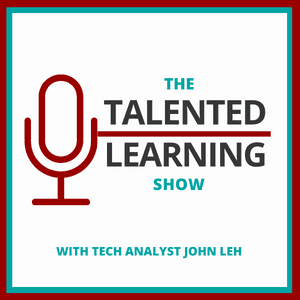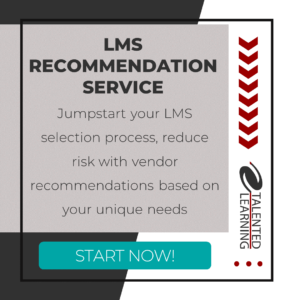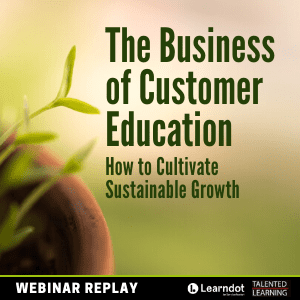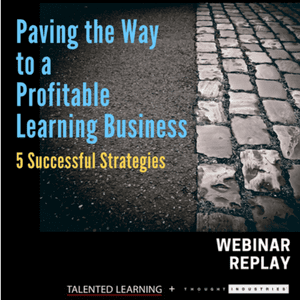
Podcast: Play in new window | Download
Subscribe: Apple Podcasts | Spotify | Amazon Music | Android | iHeartRadio | Blubrry | Email | RSS
EPISODE 21 – TOPIC SUMMARY AND GUEST:
As an independent learning systems consultant, I’m obsessed with finding the ideal solution for each client’s unique needs. Fortunately, I’m not alone in that quest. For example, today’s guest, Chad Stewart of SmartThoughts LLC, specializes in helping non-profit organizations navigate the association software selection process for all kinds of operational needs.
I invite you to join Chad and me, as we compare notes about key technology trends and their implications for association software buyers.
KEY TAKEAWAYS:
- Thanks to technology innovation, member-based organizations are facing significant opportunities and challenges.
- In particular, the center-of-gravity for association software has shifted from all-in-one AMS platforms to diverse ecosystems.
- With so much at stake, association software selection has become a strategic priority that non-profits can’t afford to treat lightly.
Q&A HIGHLIGHTS:
You and I are two sides of the same coin, Chad. We both help associations find software that meets their strategic needs, right?
Yes, our missions are very similar. At SmartThoughts, I work with non-profit organizations that are struggling to find the right systems. I assess their existing technology and help them find the best fit for their particular needs.
Our approach sounds identical. But I focus on learning solutions, while you focus on the rest of the association software ecosystem…
Also, like you John, I don’t derive any income from software implementation, training and support – although I think those services are very important. In fact, I originally offered implementation, training and support when I founded SmartThoughts in 2001.
Back then, software was installed on desktops and servers, so clients had different needs. But now with cloud computing, it’s more important to focus on the front-end of the process, helping clients find the right fit.
Interesting. I don’t cross paths with many other systems selection specialists. Why did you move to this side of the fence?
Honestly, so many new products are available and there’s so much confusion about how to choose systems. There’s a huge disconnect between buyers and sellers. So it makes a lot of sense to rely on an intermediary as an independent guide and advocate.
And why do you specialize in association software?
That shift was actually a gradual process. I started as a specialist in ERP and CRM systems for organizations of all types. But over time, as we began serving more member-based organizations, that naturally became our focus.
Excellent. So, what are the major technology components associations rely upon today?
Oh, gosh, it’s all over the place. And nomenclature is, too, because systems in the for-profit world are similar, but the acronyms are a bit different.
How so?
For example, a customer relationship management system (or CRM) is the terminology most businesses use when talking about customer-focused systems, right? Well, in the association space, the equivalent is an association management system (or AMS).
But an AMS is much more than just a CRM. It’s really an ecosystem that can include a website, marketing automation, event management, ecommerce, membership dues management, financial accounting and online community functionality. Sometimes even learning management is part of AMS capabilities.
With so many moving parts, how do you find the best fit?
Great question. An AMS may purport to be an ideal all-in-one solution. But an AMS can’t be all things to all organizations. And with so many components in the typical association software stack, best-of-class systems may be a better option for some capabilities.
OK. So let’s use learning functionality to understand this concept. How do you know when a specialized LMS is needed beyond the AMS, itself?
With each organization, I start by defining the situation. As we pull back the layers of the onion in that discovery process, it reveals what an AMS uniquely means to that organization.
For some, education and training may be critical, so specialized learning management capabilities would be a requirement.
That makes sense…
LMS components definitely are not a core competency of an AMS, in general, but you may find the capacity to track education activities. For example, you’ll see the ability to track continuing education credits or certifications.
But my job is to define what’s most important for a client. What makes that organization unique? That’s the key.
Absolutely…
Usually, that ties back to money. What’s are primary sources of revenue? Sometimes its dues. Sometimes it’s education. Sometimes it’s conferences fees. Often, there are multiple choices.
An organization needs to understand what drives revenues and choose an association software system that is strong at supporting those functions.
Agree. So, what are the top trends you’re seeing?
Well, that’s a good segue, because I see an increasing need to integrate with third-party systems. As organizations evolve, they sometimes outgrow specific capabilities in their AMS, so there’s a need to tap into more sophisticated, specialized functionality.
This is especially true of organizations using dated, all-in-one AMS platforms. But the need for expanded technology doesn’t necessarily mean an organization, itself, is growing.
Good point!
For example, one of my clients is a small association with a staff of less than five people. But this organization has relatively sophisticated needs.
They have international reach and their financial accounting is fairly advanced. They also host some very unique events, and most of their revenues come from those events.
They realize that a traditional AMS isn’t enough. So they want to find an association software system with strong event capabilities that also integrates with their core AMS and their website.
Makes sense…
It’s important to be open to a “best-of-need” approach. This calls for third-party APIs and services that integrate specialized applications into everyday workflows, so associations don’t have to give up anything in terms of understanding member information.
How do you see that playing out?
An association may not be able to get the best standalone platform for every need – for example, job board, email marketing, community management and learning management. But they’ll find an AMS with strong membership management at its core. Then they’ll add-in components to achieve their mission.
So, the underlying AMS will continue to play its primary historical role, but the organization can look beyond the AMS for specialized functionality. That’s more like a best-of-class strategy.
Excellent. Any other notable trends on your radar?
A related trend is increasing interest in what the for-profit world calls customer data platforms or CDPs. With so many systems working in tandem, associations want a central repository that provides access to a persistent, unified “master” record of every member.
It’s essential to consolidate and synthesize relevant data into a “true” single member profile. With a CDP in place, an organization’s relationship with each individual is more accurately and intelligently reflected in reports.
Interesting. So the AMS is no longer the center of the universe. But are associations struggling with the technical aspects of data integration?
Well, one reason why organizations move to a new system is just what you mentioned – integration issues. Their AMS is based on a closed architecture, so they’re opting for systems that are open and based on standards that facilitate back-and-forth integration.
Many systems of yesteryear were based on closed logic. Those legacy systems may not yet support full data exchange. But modern AMS systems usually offer open APIs to connect back-and-forth with other systems.
I see…
So, integration issues often motivate associations to change. They may change to a new AMS if their system isn’t keeping up with their integration needs. Or they’ll look for an integration services provider that knows their system fairly well and has a third-party relationship with whatever specialized system they want to add.
So about API strategy, are you seeing a trend in how AMS vendors approach this?
I can’t say there’s a clear trend, per se. But I think AMS providers definitely realize that they need to develop integrations for and with specialized systems that offer popular functionality.
What would you say those systems are?
Well, every year, I ask organizations which third-party systems they use in conjunction with their membership management system. Usually, the top of the list includes email marketing, mobile apps, job board, advertising, LMS and community management platforms.
It sounds like the AMS market is as diverse as the learning systems realm. Currently, we see more than 800 learning-related systems on our radar…
800? My goodness, that’s a lot of systems to track!
I’m tracking 128 AMS platforms – or vendors that say they offer membership-based systems. Every few weeks, I find another system that I may not have known, or a vendor goes out of business. So it changes. But it’s around 130 systems…
Oh, I’ve personally reviewed only about 200 of the 800+ systems on our radar, so I have a long way to go. How much do you track about each AMS? What’s your methodology?
That’s a great question! We publish a variety of lists on our website, and there’s no cost to be included. I’m just inquisitive by nature and it’s my job to be aware of the landscape. So I continually explore, evaluate and categorize systems.
I reach out to vendors and review their platform in-depth, even before I have clients that may be an applicable fit. I talk with these companies about their product positioning and I’ll go through a demo process. Then I’ll develop what I call a product report. Finally, I categorize the system and assign a specific fit, based on heuristics (or industry rules-of-thumb).
Yep. Our approach is nearly identical…
Also, since technology is constantly changing, I may re-evaluate a product once a quarter – or sooner, if a client is interested in a particular category.
Do you talk with customers about their experience?
Oh yes. Because we’re always gathering references and we know people who are using these systems, we capture their feedback, too. That adds another dimension to our understanding of each platform’s strengths and weaknesses.
Yeah. Anecdotal information is a great reality check…
FOR MORE QUESTIONS AND COMPLETE ANSWERS, LISTEN TO THE FULL PODCAST NOW!
Want to Learn More? Replay our webinar:
Bridging the Learning Analytics Gap: How Guided Insights Lead to Better Results
Even with cutting-edge measurement tools, many struggle to find enough time and expertise to generate useful learning insights. How can you bridge this critical analytics gap?
Join John Leh, CEO and Lead Analyst at Talented Learning, and Tamer Ali, Co-Founder and Director at Authentic Learning Labs. You’ll discover:
- Top learning analytics challenges
- How AI-driven data visualization tools are transforming learning insights
- How to define and interpret relevant metrics
- Practical examples of AI-based analytics in action
- How to build a convincing case for guided analytics
REPLAY THE WEBINAR NOW!
Need Proven LMS Selection Guidance?
Looking for a learning platform that truly fits your organization’s needs? We’re here to help! Submit the form below to schedule a free preliminary consultation at your convenience.





